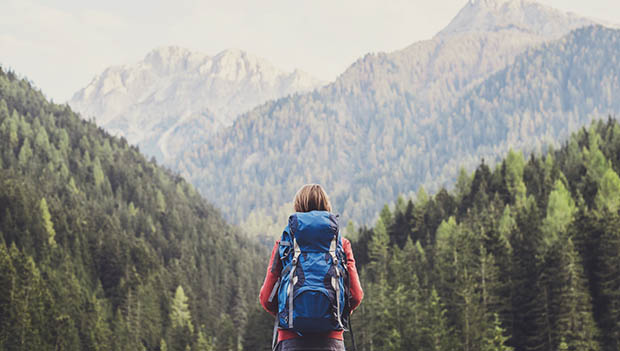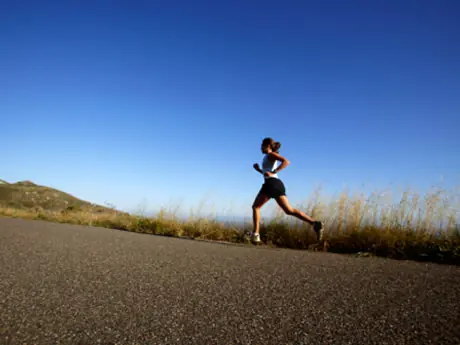
If you combine trail running with ultra-light backpacking what do you get? Fastpacking! This outdoor adventure allows nature lovers to cover more ground faster than traditional backpacking or through-hiking, and it allows trail runners access to more remote places than they'd be able to reach on even their longest runs. Plus, for those with a competitive streak, it offers the chance to set trail records known as Fastest Known Times (FKTs).
In this article, we'll dive deep into the world of fastpacking, interview a record-holding expert and give you tips on how to transition from trail running, including what to carry on your first fastpacking adventure.
Embracing the Suck
This ultra-running mantra is probably the best way to sum up what fastpacking is really all about. Rather than a steady-paced, multi-day backpacking trip—or a grueling, day-long trail run—fastpacking combines the two. It's a way to cover hundreds of miles in days rather than weeks and is all about testing your physical and mental toughness. It's also a great way to spend time out in nature and earn some serious bragging rights.
Ajay Picket of Woodbury, Minnesota, holds the unsupported FKT on Minnesota's rugged 310-mile Superior Hiking Trail. Picket completed the journey in 7 days, 20 hours, and 56 minutes in September of 2018. The "unsupported" notation is an important one—it means that Picket carried everything he needed for the entire journey from the start, rather than stashing food, water, or supplies at strategic locations (self-supported) or having friends meet him on the trail with necessary items (supported). In other words, he was the perfect person to ask for advice on getting into this crazy sport.
Learn How to Overnight in the Woods
Picket's biggest piece of advice was to learn how to spend more than one day on the trail. "Try multi-day adventures, try backpacking or even just camping in the woods." He explained that trail runners should find out whether they even enjoy being out in nature for days on end before adding in the challenge of back-to-back-to-back big-mileage days. First and foremost, get familiar with the gear and skills necessary to live in the outdoors.
Pro Tip: Borrow backpacking gear before you buy. Lightweight gear is really expensive, so make sure this is something you really want to do before you commit financially.
Miles Upon Miles
If you plan to eventually shoot for an FKT, or even just hit a less ambitious personal time goal on a long trail, Picket advises that you gradually add miles and days over weeks or months, training the same way you would for any big event.
"Lots of ultrarunners have tried to break my record, and they've all failed because they're all used to doing just a day or two. They don't have that experience of what happens to your body on day three or day four," he says. In Picket's case, on day five of his FKT run he caught a root and injured his leg badly but had built enough time on the front end to continue trying to break the record. He walked the last 110 miles in pain which he described as "9.5 out of 10." When he finally had the leg examined, it turned out to be fractured.
As far as speed is concerned, it's not really important. "The ratio of running too fast walking or hiking is skewed to walking on an unsupported FKT. The key is in not stopping," Picket says. To set the trail record, he hit the trail by 6:30 every morning and usually finished around 9:00 or 9:30 at night. "For the most part, I only sat down for 30 to 45 minutes each day for lunch."
Pack Light
If you're planning an unsupported fastpack, be prepared to be uncomfortable because you'll have to save room and weight in your pack for food and water. Picket's pack weighed 27 pounds at the start of the trail, but 19 pounds of that was food—leaving only eight pounds for his shelter, bedding, extra clothing, emergency supplies, and the pack itself. For water, he carried a one-liter filter bottle in his hand and sipped as he walked.
Carrying more or heavier gear may make for warmer nights and better sleep, but it will also increase the wear and tear on your body, making you more likely to get injured and less likely to finish.
What you absolutely can't skimp on, however, are the 10 Essentials of Hiking: shelter, water, food, navigation, illumination, sun protection, first aid, fire, repair kit and tools and extra clothing.
Making the Transition
If this crazy sport sounds like something you could get addicted to, Picket suggests trying a few supported or self-supported trips first. This will give you the chance to try out your gear and get used to putting long miles on your legs day after day while allowing you to carry a lighter load.
Pro Tip: It's a good idea to plan your first few trips along routes you are familiar with and that are easily accessed by roadways and/or pass through or near towns. That way if you get in trouble, you won't be stranded in the woods far from help. If you can talk someone else into going with you, that's even better.
Gear for Your First Trip
The good news about fastpacking is that if you have the 10 Essentials, you have pretty much everything you need for your journey.
For navigation, your phone will work well, as long as you have a way to charge it or you bring enough backup power. Your GPS will work even without a cell connection, but be sure to download maps and navigation apps for offline use before you go. And, of course, bring a paper map and old-school compass with you in case something happens to your phone.
Where shelter is concerned, you can spend $15 for a rain poncho that doubles as a tarp tent or close to $1,000 for the latest, lightest, most high-tech tent money can buy. In either case, your shelter should weigh between one and two pounds, keep you dry and act as a windbreak.
If you'll be fastpacking where temperatures drop below 65 degrees at night, you will also need to insulate yourself or risk hypothermia. A lightweight sleeping pad, to keep you off the ground and a down or synthetic sleeping bag or quilt will probably be necessary. Again, the options range in price from tens to hundreds of dollars, with comfort, performance, weight, and pack size all factoring into the cost.
Water is of primary concern. If your route includes reliable year-round water sources, you can get away with bringing just a water bottle and a lightweight filter system. If the area is experiencing a dry spell or you'll be running through arid stretches, you will have to carry many pounds of water, so you'll likely want a hydration bladder system.
As with all running pursuits, you should wear lightweight, wicking clothes in layers and bring at least one extra pair of socks. For sun protection, hats, bandanas, and other sun-blocking garments can often perform better than lotions, especially if you sweat a lot.
Headlamps, fire kits, first aid, and survival tool kits are all easily found online at affordable prices.
So that just leaves food. Look for things that pack a lot of calories into a relatively small and light package. But be sure to practice with your choices on shorter excursions or you'll risk getting the runs while you're far away from indoor plumbing and running water.
Embracing the suck is a key skill in fastpacking, but overall those moments are fleeting. "Are there dark times out there? Sure," Picket says. "But I'm doing things people haven't done before, that I haven't done before. I love being out in nature, and it's really freeing to be outside by yourself for a week at a time."
READ THIS NEXT: Trail Running Etiquette Tips
Get ACTIVE on the Go


Couch to 5K®
The best way to get new runners off the couch and across the finish line of their first 5K.
Available for iOS | Android







Discuss This Article